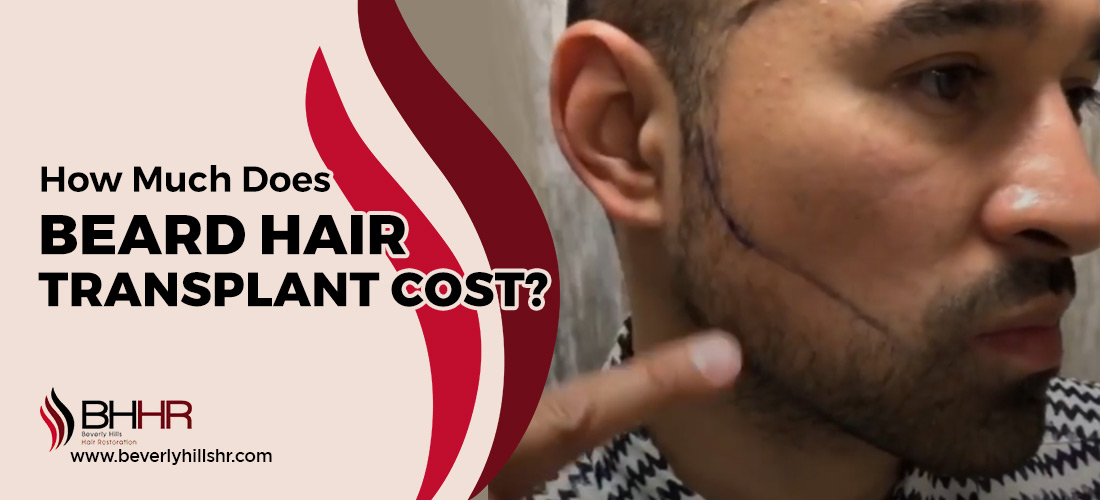How Much Does Beard Hair Transplant Cost?
Home / Beard Hair Transplant / How Much Does Beard Hair Transplant Cost?
Updated On : October 17, 2025 | Category : Beard Hair Transplant | Author: Beverly Hills Hair Restoration Team

Understanding the costs of beard transplants is crucial for anyone considering this cosmetic procedure. At Beverly Hills Hair Restoration in Los Angeles, we strive to provide transparency and clarity about the financial aspects of facial hair transplants. This article offers a complete guide to the various factors contributing to the procedure's overall cost. By delving into elements such as the extent of transplantation required, the chosen technique, and the surgeon's expertise, we aim to equip our readers with the necessary information to make well-informed decisions. Our ultimate goal is to demystify the costs associated with beard transplant, enabling individuals to assess the value of this investment in their appearance and self-confidence.
Factors Affecting Beard Hair Transplant Cost
Understanding these factors is crucial in anticipating the final cost of the procedure. Patients should consult Dr. John Kahen for a personalized estimate tailored to their needs and desired outcomes. The expenses of Beard hair transplants at Beverly Hills Hair Restoration in LA can vary based on several factors:
Extent of Hair Loss:
The severity and area of hair loss directly impact the cost. A larger area requiring transplantation will necessitate more grafts, increasing the overall expense. The complexity of the desired facial hair pattern and density also affects the cost.
Number of Grafts Required:
The total number of grafts needed to achieve the desired outcome is a significant factor in cost determination. More grafts require more time and resources, increasing beard hair transplant prices.
Quality of Donor Hair:
The amount and quality of available donor hair are critical factors. Patients with limited or poor-quality donor hair may require additional procedures or more advanced techniques to achieve the desired results, increasing costs.
Beard Hair Transplant Technique:
The technique used for the transplant, such as Follicular Unit Extraction or Follicular Unit Transplantation, can influence the overall cost. FUE, which involves individually extracting hair follicles, is often more time-consuming and may be priced higher than FUT, where a strip of hair is removed and dissected into grafts.
Boost Your Beard Growth with Minoxidil!
Support your beard transplant with Finasteride & Minoxidil Spray. This powerful formula boosts regrowth, strengthens your beard, and delivers fuller results in 3-6 months.
Order now
Average Cost of Beard Hair Transplant
On average, a beard hair transplant cost at Beverly Hills Hair Restoration would cost about $5,756. Depending on various factors, such as the extent of the transplant and the technique used, beard transplant expenses can range from $1,400 to $14,192. Book a free hair transplant consultation at our hair transplant clinic beforehand to check their prices and receive a detailed cost breakdown tailored to your specific needs.
Long-Term Value of Beard Hair Transplant
Investing in a Beard hair transplant at Beverly Hills Hair Restoration in Los Angeles is more than just a financial commitment; it's an investment in your confidence and satisfaction. While the initial cost is a consideration, the long-term benefits make it a valuable choice. We aim to provide high-quality care to help you achieve desired results, ensuring that every dollar spent is worth it for your well-being.
Boost in Self-Confidence:
One of the most significant benefits is the boost in self-confidence that a fuller, more defined beard or mustache can provide. This enhanced appearance can lead to greater self-assurance in social and professional settings.
Long-Term Investment in Appearance:
A Beard hair transplant is a long-term investment in your appearance. Unlike temporary solutions, the results of a transplant are permanent, providing a lasting solution to facial hair loss or thinning.
Conclusion
The Beard Hair Transplant Cost at Beverly Hills Hair Restoration in Los Angeles is determined by various factors. Even though the initial expense may seem high, the value of a Beard hair transplant lies in its ability to boost self-confidence, provide long-lasting improvements in appearance, and offer significant psychological benefits. We encourage individuals considering Beard hair transplants to research, understand the costs, and make informed decisions that align with their aesthetic purposes and budget. Our hair transplant clinic in Los Angeles ensures that patients achieve the best possible outcomes from their beard hair transplant journey.
Begin your journey towards natural-looking, confident hair restoration with a complimentary free hair transplant consultation at Beverly Hills Hair Restoration. Call 310.289.0901 or visit our clinic to schedule your free appointment today.
FAQs About Beard Hair Transplant Cost
1. How long does the Beard hair transplant procedure take at BHHR?
The Beard hair transplant at BHHR takes 2 to 5 hours. Recovery is quick, with most resuming activities in days. Mild swelling or discomfort may occur but usually subsides within a week.
2. Does insurance cover the Beard Hair Transplant Cost at BHHR?
Beard hair transplants are usually not covered by insurance since they are considered cosmetic procedures. Patients should verify with their insurance provider for precise coverage information.
3. Can I get an exact quote for my Beard Hair Transplant Cost before deciding?
During a consultation with Dr. John Kahen at BHHR, you can receive an exact quote for your Beard hair transplant cost. Dr. Kahen will assess your needs and provide a personalized quote based on your desired outcomes.
4. Is there any consultation fee for discussing Beard Hair Transplant Costs at BHHR?
There is no consultation fee to discuss Beard Hair Transplant Costs at BHHR. We offer a free Hair Transplant Consultation, where you can meet with Dr. John Kahen, discuss your needs, and receive a personalized estimate for your procedure.
